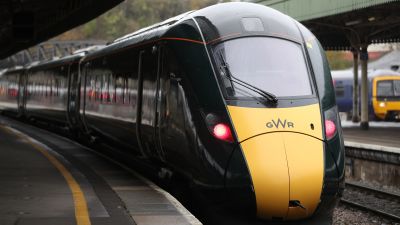Great Western Railway worker hit by train travelling too fast, report finds

Great Western Railway failed to control risks when a worker was hit by a train at a depot in Bristol, a report has found.
They were seriously injured at the St Philip's Marsh depot in September 2023.
A report by the Rail Accidents Investigation Branch said that trains there were exceeding the speed limit.
Sequence of events
At around 1pm on 26 September 2023, a member of staff responsible for shunting the trains was struck by one that was leaving the main shed.
It was travelling at 10mph at the time, the RAIB said.
After hearing the train hit something, the driver stopped.
Others working nearby saw that the shunter was lying next to the train and went to help them.
After exiting the main shed building via a roller shutter door, the shunter had walked into the path of a train.
Its driver had then started to move it and accelerate much quicker than the shunter expected.
The shunter took this route to get to a level crossing that ran across the end of the shed building.
According to the report, the shunter did this because they wanted to check that no one was approaching the level crossing from a blind corner.
The shunter regularly used the area between the main shed building and the level crossing as a walking route, so was used to being there.
However, by using this route the shunter had to walk close to or foul of the train’s path.
The shunter was also unaware that the train had started to move and did not realise it was catching up with them.
They had expected to reach the level crossing before the train, but the train exceeded the speed limit of 5mph or 8 kmh.
The driver did not observe the shunter walking ahead of the train so did not take any appropriate actions in response.
The shunter, who had sustained serious injuries, was treated by paramedics and then taken to hospital.
GWR response
The RAIB found that an underlying factor was that GWR had not effectively controlled the risk of a shunter being struck by a train outside a shed building.
GWR’s assurance processes also had not identified that train movements within the depot were exceeding the speed limit.
Following the accident, GWR updated its risk assessment and introduced new control measures to specifically manage the risks to staff associated with trains moving outside the main shed building.
GWR also addressed the deficiencies found with its assurance processes for monitoring if drivers were complying with the speed limits on its depots.
A GWR spokesperson said: "We recognise that this was a very serious incident to a member of our team.
"We have conducted a thorough review of our risk mitigations; identified options to reduce those risks, and continue the work of implementation.
"This includes addressing the recommendations made by the RAIB to review personal track safety certification standards and walking routes at our depots.
"The safety of our colleagues and our passengers is our highest priority."
Recommendations
Following the investigation, the RAIB made two recommendations to GWR.
1. Review the personal track safety training and assessment it provides for shunters, so that they receive an appropriate level of information and assessment about working and walking on depots.
2. Identify the places on its depots where its staff might be required to walk foul of a train’s path when using a walking route or walkway, and then manage the risk of its staff being struck by a train in these locations.